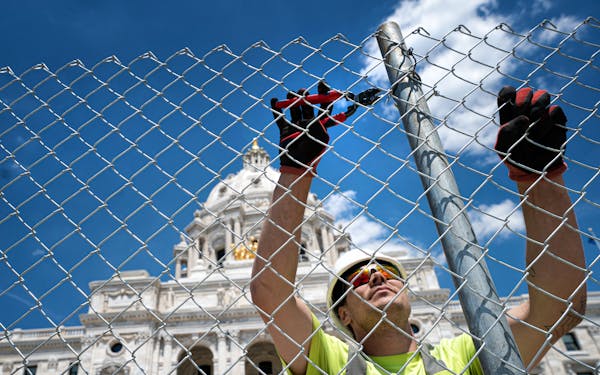Brany Guevara and her daughter looked up in awe at the masonry dome inside the Minnesota Capitol on Thursday, admiring nearby paintings before climbing the smooth marble steps leading to the state Senate chamber.
They were among the first members of the public to stand inside the building in 440 days, after the pandemic shut people out of the People's House for the longest period in state history.
"I feel like now life is coming back to normal," said Guevara, who drove from St. Cloud to St. Paul to show off the building to family visiting from Colombia.
The reopening of the Minnesota Capitol to visitors on Thursday marked a kind of normalcy. The historical society office in the building opened its doors as families wandered in for self-guided tours. Advocacy groups held news conferences in the building to make their cases for a bite out of the state's $52 billion budget, which lawmakers are still debating.
"This house is open. We've got folks here passionately advocating for their issues," said Gov. Tim Walz just outside his Capitol office. "This is the normal that we kind of wanted to get back to and now democracy can be done the way it's supposed to: passionately, respectfully and at the end of the day reaching compromise."
The reopening comes just a week after crews tore down an 8-foot fence that had encircled the outside of the Capitol since unrest following George Floyd's killing last May.
At one point, the Minnesota National Guard occupied the building after credible threats of damage to the 117-year-old structure.
The Minnesota State Patrol has remained on guard for the past year.
The Capitol has occasionally closed to the public over the years, including during the 20-day government shutdown in 2011 and for a few days after the 9/11 terrorist attacks.
Areas of the building were closed off during a multiyear restoration project, but this is the longest it's ever been entirely closed off to the public, said Brian Pease, historic site manager for the Minnesota Capitol.
"Since it is the most public building in the state that represents many things to many people, closing it should be a last option," said Pease. "During times of crisis or mourning, outrage, concern or celebrations, it remains a beacon for citizens."
During the many months of closure since last March, policymakers and state officials have weighed safety concerns with calls for transparency in setting the state budget.
Rich Neumeister, an open-government advocate who has spent 44 sessions as a citizen lobbyist in St. Paul, was overjoyed to see people back in the building on Thursday. He was also on the hunt for legislators to buttonhole and question about the status of budget negotiations.
"The physicality of place and politics is an important part of the process," Neumeister said.
Lawmakers are expected to mostly return to the building next week to continue work on the state budget after nearly two full sessions operating mostly remotely.
Even as the building opens back up, the mark of the pandemic is indelible.
The first public group to hold a news conference inside the building in 15 months asked lawmakers to pump federal funding into substance-use treatment programs after addiction issues spiked during lockdown.
"Everyone has been affected by COVID," said John Magnuson, executive director of the Minnesota Association of Resources for Recovery and Chemical Health. "As we start to move back to normal, we anticipate a tsunami of need."
Briana Bierschbach • 651-925-5042
Twitter: @bbierschbach
Arizona judge rejects GOP wording for voters' abortion ballot initiative pamphlet
Netanyahu meets with Trump at Mar-a-Lago, offering measured optimism on a Gaza cease-fire
FBI says Trump was indeed struck by bullet during assassination attempt

